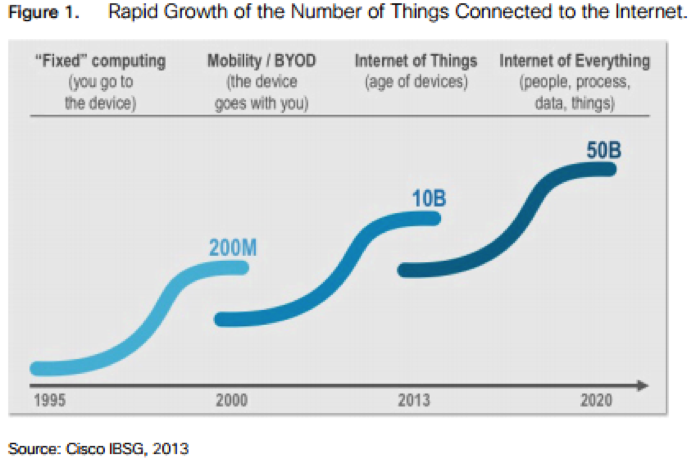IoE, M2M, whatever you want to call it. The general buzzword du jour is the grand sounding Internet of Everything, which sounds good, but is perhaps too broad in scope to really be meaningful. What we really mean by the term “Internet of Everything” is devices talking to other devices using Internet Protocol 6 (IPv6). But, you might think, Machine-to-Machine (M2M) communication has been around for a little while, so what’s the big deal?
Well, the big deal is a potential industry value at stake of $14.4 trillion dollars according to Cisco, based on the fact that 99% of objects that might be part of the Internet of Everything are not currently connected. We’re talking everything from smart washing machines to healthcare patient monitoring systems, to interactive billboards and games.
Chairman and CEO of Cisco Carlos Dominguez says that “connected devices will evolve to sense, collect, transmit, and analyse data that quickly delivers insights to help achieve our desired outcomes. The true power will come about when multiple data source and streams from proprietary and open sources are combined to deliver a unique personal experience.”
The problem that is preventing this wondrous new age is the legacy problem of IPv6 lacking backwards compatibility with IPv4. This may not sound like much, but the Internet Society (ISOC) says that ISPs, enterprises and network equipment vendors report that there are “no concrete business drivers for IPv6.” This is a serious issue seeing that M2M requires the extra Internet connections of IPv6 to work. IPv4 just cannot cope with the numbers required. Like always, the driver towards IPv6 will be the consumer base and forward thinking companies who get ahead of the game. Of course, Google can provide all of its services over IPv6, and Comcast has developed IPv6 transmission for its broadband subscribers. In addition, as of 2010 the US Government has mandated that all hardware and software sold to the Fed must be IPv6 compatible. Even with the heavyweights, Cisco estimates that 69% of IoE’s value to the public sector will be generated by smart implementations focused on the public – you and I. Smart parking systems, smart lighting, and even the usage of video tech in court cases- are each bundled up into the Internet of Everything. If you didn’t know already, IoE really does comprise a broad scope.
In the world at large, M2M is changing the way we drive, with connected cars now at a level at which they can be mass-produced (with O2 and Orange leading the way). The adherence to Moore’s Law that the tech industry follows in terms of processing and bandwidth coupled with advancements in Big Data analysis and actualisation is rapidly showing the financial impact of being connected. Sticking with the car industry, what is possible with M2M is something along the lines of the following: your car receives telematics about traffic from the local transport authority, and automatically suggests modifications to your route to avoid traffic – all done without human involvement. This is already being developed in Austria, where the concept of the Internet of Everything might literally be true – from the moment you wake up to when you go to sleep, you might be passively interacting with hundreds of smart devices.
It’s up to us as developers to think of the next breakthroughs, the next application of M2M. In the startup field we suppose this is an extrapolation of UX design. We’re looking for solutions to human needs and desires that we can monetise. By thinking ahead in the language of IoE, can we evolve our business idea to, say, revolutionise how kids are taught in school or find a new way to integrate supply chain and logistics to accelerate trade? The possibilities are practically endless.
What do you think about IoE? Let Venture Aviator know about how you plan to integrate M2M into your designs, and we can talk about how to maximise your results.



Leave A Comment